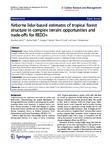Please use this identifier to cite or link to this item:
http://www.alice.cnptia.embrapa.br/alice/handle/doc/1019401| Title: | Airborne lidar-based estimates of tropical forest structure in complex terrain: opportunities and trade-offs for REDD+. |
| Authors: | LEITOLD, V.  KELLER, M.   MORTON, D. C.   COOK, B. D.   SHIMABUKURO, Y. E.   |
| Affiliation: | VERONIKA LEITOLD, INPE; MICHAEL KELLER, USDA/PESQUISADOR VISITANTE CNPM; DOUGLAS C. MORTON, NASA; BRUCE D. COOK, NASA; YOSIO E. SHIMABUKURO, INPE. |
| Date Issued: | 2015 |
| Citation: | Carbon Balance and Management, v. 10, n. 3, p. 1-12, 2015. |
| Description: | Carbon stocks and fluxes in tropical forests remain large sources of uncertainty in the global carbon budget. Airborne lidar remote sensing is a powerful tool for estimating aboveground biomass, provided that lidar measurements penetrate dense forest vegetation to generate accurate estimates of surface topography and canopy heights. Tropical forest areas with complex topography present a challenge for lidar remote sensing. |
| Keywords: | Airbone lidar Biomass estimation Canopy height Data thinning Digital terrain model Elevation accuracy REDD+ Tropical montane forest |
| DOI: | 10.1186/s13021-015-0013-x |
| Type of Material: | Artigo de periódico |
| Access: | openAccess |
| Appears in Collections: | Artigo em periódico indexado (CNPM)  |










